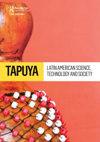南大西洋科技研究:历史与实践
IF 1.2
Q2 HISTORY & PHILOSOPHY OF SCIENCE
Tapuya: Latin American Science, Technology and Society
Pub Date : 2022-11-11
DOI:10.1080/25729861.2022.2128593
引用次数: 0
摘要
在美国,人们对(所谓的)拉丁美洲和加勒比地区的非洲裔民族的历史知之甚少。这是不幸的。今天,非洲人或非洲人后裔占该地区人口的33%。是什么导致了这种不可见?本文章由计算机程序翻译,如有差异,请以英文原文为准。
South Atlantic science and technology studies: histories and practices
The history of the peoples of African origin in (so-called) Latin America and the Caribbean is largely unknown in the United States. This is unfortunate. Africans or people of African descent today represent 33% of the population in the region. 1 What accounts for this invisibility?
求助全文
通过发布文献求助,成功后即可免费获取论文全文。
去求助
来源期刊

Tapuya: Latin American Science, Technology and Society
Social Sciences-Social Sciences (all)
CiteScore
1.60
自引率
0.00%
发文量
39
审稿时长
19 weeks
 求助内容:
求助内容: 应助结果提醒方式:
应助结果提醒方式:


